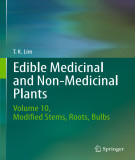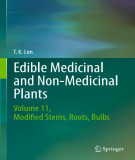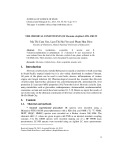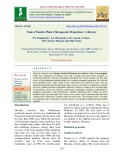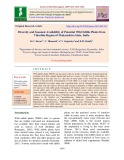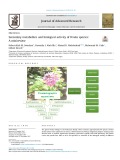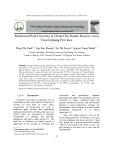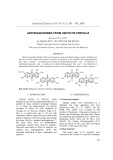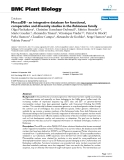
Family Rubiaceae
-
Ebook "Edible medicinal and non-medicinal plants - Volume 5: Fruits" covers selected species from the following families: Apiaceae, Brassicaceae, Chenopodiaceae, Cunoniaceae, Lythraceae, Papaveraceae, Poaceae, Polygalaceae, Polygonaceae, Proteaceae, Ranunculaceae, Rhamnaceae, Rubiaceae, Salicaceae, Santalaceae, Xanthorrhoeaceae and Zingiberaceae. Topics covered include: taxonomy; common/English and vernacular names; origin and distribution; agroecology; edible plant parts and uses; botany; nutritive/pharmacological properties, medicinal uses, nonedible uses; and selected references.
 954p
954p  damtuyetha
damtuyetha
 16-02-2023
16-02-2023
 1
1
 1
1
 Download
Download
-
Ebook "Edible medicinal and non-medicinal plants - Volume 10: Modified stems, roots, bulbs" with 59 plant species with edible modified stems, roots and bulbs in the families Amaranthaceae, Cannaceae, Cibotiaceae, Convolvulaceae, Cyperaceae, Dioscoreaceae, Euphorbiaceae, Fabaceae, Iridaceae, Lamiaceae, Marantaceae, Nelumbonaceae, Nyctaginaceae, Nymphaeaceae, Orchidaceae, Oxalidaceae, Piperaceae, Poaceae, Rubiaceae, Simaroubaceae, Solanaceae, Tropaeolaceae, Typhaceae and Zingiberaceae.
 670p
670p  damtuyetha
damtuyetha
 16-02-2023
16-02-2023
 2
2
 1
1
 Download
Download
-
Ebook "Edible medicinal and non-medicinal plants - Volume 11: Modified stems, roots, bulbs" covers selected plant species with edible modified stems, roots and bulbs in the families Iridaceae, Lamiaceae, Marantaceae, Nelumbonaceae, Nyctaginaceae, Nymphaeaceae, Orchidaceae, Oxalidaceae, Piperaceae, Poaceae, Rubiaceae and Simaroubaceae. The edible species dealt with in this work include wild and underutilized crops and also common and widely grown ornamentals.To help in identification of the plant and edible parts coloured illustrations are included.
 403p
403p  damtuyetha
damtuyetha
 16-02-2023
16-02-2023
 5
5
 1
1
 Download
Download
-
Five metabolites, scopoletin 1, ursolic acid 2, 5-(hydroxymethyl)furan-2-carbaldehyde 3, B-sitosterol 4 and daucosterol 5, were isolated from the fruit of the Morinda citrifolia Linn. plant, collected in Ho Chi Minh City. Their structures were elucidated by spectroscopic analysis.
 6p
6p  tamynhan8
tamynhan8
 04-11-2020
04-11-2020
 15
15
 1
1
 Download
Download
-
Morinda citrifolia Linn. belongs to family Rubiaceae, also called as „noni‟ is an evergreen shrub that originated in Southeast Asia and is being used from many centuries as traditional medicine. Various communities throughout the world consume the fruit and leaves of this traditional medicinal plant for its various therapeutic properties. M. citrifolia parts including fruits, seeds, barks, leaves, and flowers are utilized on their own for individual nutritional and therapeutical values, however, the fruit is considered to contain the most valuable chemical compounds.
 7p
7p  kethamoi4
kethamoi4
 16-04-2020
16-04-2020
 14
14
 1
1
 Download
Download
-
Wild edible plants (WEPs) are the species that are neither cultivated nor domesticated, but available from their natural habitat and used as a source of food. Use of wild edibles is diminishing at fast pace but it is clear that in many parts of the world the use of wild edibles is still prevalent. Consumption of wild edibles is a major source of vitamins and micro-nutrients for people using only vegetarian diets rich in carbohydrates.
 13p
13p  cothumenhmong1
cothumenhmong1
 08-12-2019
08-12-2019
 14
14
 2
2
 Download
Download
-
The genus Pentas belongs to the Rubiaceae family, which contains approximately 40 species. Several Pentas species were reported to be used as a folk treatment by African indigenous people in treating some diseases such as malaria, tapeworms, dysentery, gonorrhea, syphilis and snake poisoning. This article covers the period from 1962 to 2017 and presents an overview of the biological activity of different Pentas species and describes their phytochemical traits.
 10p
10p  trinhthamhodang1
trinhthamhodang1
 14-11-2019
14-11-2019
 11
11
 0
0
 Download
Download
-
The richest 3 families are Euphorbiaceae with 22 (4.97%) species, Rubiaceae with 17 (3.83%) species and Asteraceae ranks third, with 16 (3.61%) species, respectively. When the medicinal plant of the area are analysed by Raunkiaer’s life form system, the results are follows as: phanerophytes 311 (73.18%), chamaephytes 45 (10.59%), hemicryptophytes 10 (2.355%), cryptophytes 33 (7.76%), and therophytes 26 (6.12%) species, respectively.
 5p
5p  cathydoll4
cathydoll4
 21-02-2019
21-02-2019
 21
21
 0
0
 Download
Download
-
Hedyotis pinifolia Wall ex G.Don (Vietnamsese name An điền l¸ th«ng), family of Rubiaceae, has not yet been chemically studied. From the aerial parts of H. pinifolia, four anthraquinones had been isolated: 1,6-dihydroxy-7-methoxy-2-methylanthraquinone (1), 1,6-dihydroxy-2- methylanthraquinone (2), 3,6-dihydroxy-2-methylanthraquinon (3) and 1,3,6-trihydroxy-2- methylanthraquinone (4). Their chemical structures were established by spectroscopic analysis.
 6p
6p  giesumanh
giesumanh
 13-11-2018
13-11-2018
 5
5
 0
0
 Download
Download
-
Tuyển tập báo cáo các nghiên cứu khoa học quốc tế ngành y học dành cho các bạn tham khảo đề tài: MoccaDB - an integrative database for functional, comparative and diversity studies in the Rubiaceae family
 11p
11p  panasonic06
panasonic06
 25-12-2011
25-12-2011
 48
48
 2
2
 Download
Download
CHỦ ĐỀ BẠN MUỐN TÌM









